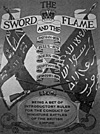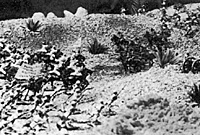 ED NOTE: This compilation of errata and rule clarifications to SWORD & FLAME by the rules author is printed with the kind permission of the rules publisher YAQUINTO PUBLICATIONS, INC. This article may be photocopied for inclusion in your rule set.
ED NOTE: This compilation of errata and rule clarifications to SWORD & FLAME by the rules author is printed with the kind permission of the rules publisher YAQUINTO PUBLICATIONS, INC. This article may be photocopied for inclusion in your rule set.
Page 14,A. Prone:
It takes one turn in place to "stand up" and on that turn the figures cannot fire and are considered "prone" for purposes of Close Combat.
Page 15, B-2. (b) Charge Move:
(2) Mounted cavalry figures using the charge move to close with the enemy do not have to roll a die and take stragglers. Using the charge move for extra distance however, they will roll for stragglers.
(4) Figures inside a walled enclosure attempting to close into combat do not have to use a "charge" move and do not take "stragglers".
Page 15, B{3) Movement Through Rough Terrain:
In place of the fractional movement penalty is indicated on the Movement Chart under "Rough Terrain", for all British, Egyptian, and Boer movement roll the prescribed number of dice and then subtract the amount in inches of the highest die rolled. Zulus, Pathans and Dervishes have no penalty moving in Rough Terrain.
Page 17, D-2-(1) Viewing of Concealed Figures
The word "on" should read "of".
Page 17-D-1-C, Moving Concealed Figures:
Figure already exposed to view can go into concealment by merely moving them therein during a movement phase and removing them from the table. Their hidden location should be recorded on paper. This applies to "Native" forces only. British troops can never be concealed.
Page 17, 6-b. Mount and Dismount:
On the turn that figures are mounting or dismounting they cannot fire.
Page 17, 6. Special Cavalry Movement
f. Charge Evasion
During the movement phase of any game turn that a mounted cavalry unit is "charged" by enemy foot soldiers attempting to close into combat the mounted unit can attempt, is so desired, to "evade" the charge, thusly:
-
1. Cavalry player announces, "I am evading", and points out the unit so doing.
2. Rolls one 6-sided die. A number "6", and his unit cannot evade. Any other number it can.
3. If the unit cannot evade it must stand in place, "dis-ordered", and if a close combat occurs, the figures fight at a minus one on the Close Combat Chart, and during the Firing Phase only 1/2 the figures may fire.
4. If he can evade, he rolls 2 dice and moves that distance away from the charging enemy. This move cannot be used to engage in any other action.
5. If the target does evade, the attacker can follow it by moving in the un-used portion (if any) of his original move-distance. A Close Combat could still occur depending on the move- distance of each party. This would be fought as normal.
6. The Cavalry "evasion" rule can be used only once per turn, per unit.
7. The evasion move can be made even if the cavalry has already made its normal move for that turn.
Page 18,C(2)-(a)
The word, "group", should read as "area". Delete number "6" before, "Figures that may not Fire", and add C.
Page 18, B. Special Rules For Firing
6. If leaders or key figures are the only targets in the target area, any casualty card turned can "hit" them. Key figures are taken out first.
7. Fire can be directed into concealment areas at suspected, un-seen targets. If any "hits" are incurred, firer merely records same on paper and when, and if, hidden units are exposed, removes casualties. Hidden player need not divulge whether there are hidden targets until they are exposed.
8. Single figures designated as "Scouts" and actually used as such during the turn to "call visibility" into concealment areas can only be hit with "key figure" casualty cards (Jack, Queen, King) if fired upon.
 9. British and Egyptian officers armed with
pistols fire separately from their units volley. They
can aim and fire at specific individual targets
within their 30" firing cone. At targets 6" to 12"
distant they get one shot (roll one die), targets
under 6" they have two shots (two dice). If the
target is upright in the open, a "5" will wound, and
a "6" will kill. Any other targets, a "6" kills.
9. British and Egyptian officers armed with
pistols fire separately from their units volley. They
can aim and fire at specific individual targets
within their 30" firing cone. At targets 6" to 12"
distant they get one shot (roll one die), targets
under 6" they have two shots (two dice). If the
target is upright in the open, a "5" will wound, and
a "6" will kill. Any other targets, a "6" kills.
10. Before firing a galling gun for effect roll one die a "6" and the gun jams that turn and does not fire.
11. British and Egyptian officers can man guns and be considered as "crewman" for purposes of firing. They forfeit their pistol shots while so engaged.
12. Units in concealment at the end of the movement phase can fire during the firing phase when their sides fire card is drawn. Expose them as they do so.
Page 18, C. Figures That May Not Fire:
- a. Delete, "concealed figures" and replace with,
"pinned f igures may not f ire".
i. Mounting or dismounting figures may not fire on the turn they are so doing.
j. Prone figures may not fire on the turn that they are "standing up".
Page 18- Firing Chart
Disregard sentence under chart "All ranges cut in half for firing by mounted figures". And add
| Unit | Maximum Range | |
|---|---|---|
| Mounted | Dismounted | |
| British Carbines | 12" | 18" |
| Egyptian Carbines | 12" | 18" |
| Boer Rifles | 18" | 30" |
Any Gatling-short, Class 1 target under column 1 should read, "1/4".
Page 19, IX -The Close Combat (Hand-To-Hand) Phase
"Close Combat Resolution" sentence above the chart should be moved to column at the right of the page and placed after sentence A-4-C as heading of next section, ie; (1. Each pair of figures. . .).
Close Combat Chart
- Pathan "charging" should read, "+1". Pathan
"defending in mass" should read "0".
Natives "charging" over walls lose their +1 combat bonus and fight as "on top of wall or barricade".
Page 19, A-3
"Shaken" figures are moved their prescribed distance to the rear and placed in a "Disordered" formation until rallied.
Page 20, C. Special Rules For Close Combat
4. Delete present C-4 and replace with, "Wounded figures cannot take part in a normal close-combat action".
3. Delete present C-3 and replace with, "On ground wounded native figures can attempt to kill (roll a 6 on the die) or wound (roll a 5) any enemy figure standing within 1 " of them at the end of a movement phase and prior to the "fire phase".
After this attempt is made, said wounded are automatically killed or captured at the opposing players discretion. (even if his upright figure has become a casualty).
Page 20, C. Special Rules For Close Combat
5. Losing figures in a close-combat (who are now "shaken") that are surrounded and must retreat, follow this procedure;
-
a. Roll 4 dice for distance to be moved (must
move towards nearest table edge)
b. Each standing survivor rolls one die. A 4, 5, or 6 and he escapes unharmed to new location. A 1, 2, or 3 and he is captured or killed at the winning players discretion. If a survivor attempts to carry a wounded comrade with him, he can only escape with a 5 or 6 on the die.
6. Close Combat Over Obstacles
-
The attacker must move up to obstacle on one
turn and stop. (He can fire!) When he decides to
"charge" over and attempt to close he announces a
"change" move and rolls 1 die for stragglers, who
stand in place. The remainder of the figures are
placed on the obstacle. If a close-combat occurs,
only these figures will take part.
7. Close Combat Against Wall Enclosures
- a. When going into close-combat against
walled enclosures each wall of the
enclosures is considered a separate close-
combat in regards to morale checks,
support, and the actual combat itself. Fight
and resolve each of these separate combats
in the order in which initial contact occured
before going on to the next one.
b. Losing elements inside an enclosure (if their 4 die-roll retreat move to their direct rear dictates,) can be driven out. If they pass through enemy units - even those that may be closing into combat - they are subject to rule C-5 (Losing figures that are surrounded).
8. Multi-Unit Close Combat
-
If various opposing units or groups attempt to
close into combat as their move cards are
drawn, then during the combat phase of the turn
fight and resolve each set of opposing units in
the order in which initial contact was
made and act according to the normal close-
combat sequence in regards to morale checks,
attacker and defender, winner and loser, and
retreating "shaken" units.
9. Stragglers from charging units that did not participate in the actual close-combat, are still subject to the results of such combat. If their parent unit won, they can join the survivors. If their unit lost, they retreat with the survivors.
Page 20, B. Critical Morale
3. "Routed" figures that are charged, or fired at
and take casualties before they have a chance to
move, make their ~dice retreat move towards the
table edge right then. If they ever get "surrounded"
they come under rule C-5 (Special Rules for Close
Combat)
After the word "checked" delete the period
(.) and add, "each turn until rallied or routed".
C-2, Pinned Morale
-
Delete the period (.) after the word "above" and
add, "and cannot fire while pinned.
Page 22, The Battle of Chamla Valley
- Due to changes in the firing system from
concept to final publication, some of the numbers
regarding casualties inflicted by fire are in error by 1
or 2 figures. This does not effect the basic narrative however.
* Acknowledgement*
My sincerest thanks to the following dedicated war gamers whose astute observations and criticisms have contributed to these clarifications, corrections and additions. The final form taken however is still my responsibility.
- Wally Simon
Jay Stribling
Dick Bryant
Mike Lowry
Frank Kalesnik
Eric Teuber
John Mumby
Robert Whitfield
Mark Stricker
Ray Koch
Back to Table of Contents -- Courier Vol. 2 #3
To Courier List of Issues
To MagWeb Master Magazine List
© Copyright 1980 by The Courier Publishing Company.
This article appears in MagWeb (Magazine Web) on the Internet World Wide Web.
Other military history articles and gaming articles are available at http://www.magweb.com